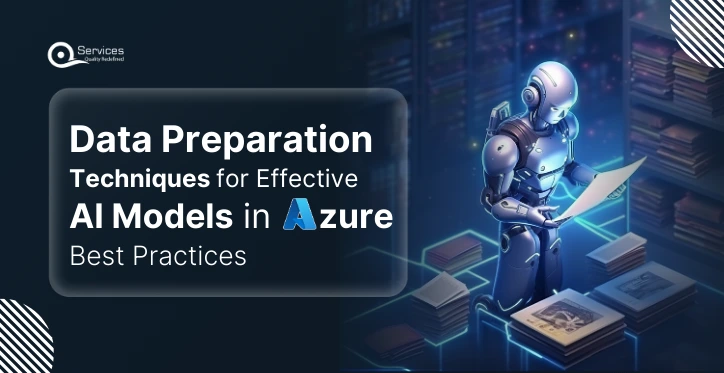Home » Data Preparation Techniques for Effective AI Models in Azure: Best Practices

AI and ML are revolutionizing industries, but here’s the catch—your machine learning project is only as good as the data you feed it. Preparing data for machine learning is a critical step that directly impacts model performance, scalability, and accuracy.
Azure provides powerful tools and platforms to simplify and automate the AI data preparation process. In this blog, we’ll explore best practices and techniques to prepare data for machine learning in Azure, while covering the essential steps in data preparation to ensure optimal results.
When we talk about machine learning, the success of any project depends on its data quality. Even the most advanced algorithms cannot perform well if the data is flawed. This is where data preparation becomes critical. A well-prepared dataset leads to:
With Azure’s tools, you can streamline this entire process, making it easier than ever to get your data ready for machine learning – so you can focus on building great models.
When it comes to machine learning, data is everything. But raw data doesn’t just jump into a model — it needs some work first. Here are the essential steps to get it ready:
Gather Your Data: First, you need to pull together all the relevant information from wherever you can — databases, APIs, or even web scraping.
Clean It Up: Raw data often comes with several errors like missing values, and duplicates. Cleaning it up ensures your model learns from good data.
Transform the Data: Once it’s clean, you’ll want to format the data so the model can understand it properly.
Simplify the Dataset: Reduce the size of the dataset by removing unnecessary data points to make processing faster, without sacrificing important information.
Split the data: Finally, you split your data into training, validation, and test sets so you can train, test, and tweak your model.
These machine learning project steps help ensure that the data you’re using makes the most of your machine learning project.
Preparing data can feel like a lot of work, but with Azure Machine Learning Studio and Azure Data Factory, it’s a whole lot easier. These tools help take care of all the complicated parts of getting your data ready.
If you’ve got a lot of data from different places, Azure Data Factory helps you create simple workflows to pull everything together, transforming and moving data with ease.
Using these tools, preparing data becomes so much simpler, helping you get to work on your machine learning models faster.
Get free Consultation and let us know your project idea to turn into an amazing digital product.
Data preparation is one of the most important steps in machine learning. You can have the best algorithm in the world, but if your data isn’t prepared well, the results will be bad. So, here’s how to make sure your data is ready:
First thing’s first, you need to make sure your data is clean and complete. If your data is messy, your model will just learn mistakes.
Now it’s time to turn your raw data into useful features that the machine can use to learn and make predictions.
If some of your data ranges are way bigger than others, the machine might focus too much on those larger numbers. So, you need to scale them down to make sure everything is on the same level.
If you have text data (like “Red” or “Blue”), you need to turn that into numbers. That way, the machine can make sense of it.
Sometimes, you collect too much data that’s not useful. You want to trim down your data to keep only the important parts.
Once your data is ready, you need to split it up to train and test your model. Here’s how you do it:
With Azure’s Automated ML, data preparation becomes a lot more manageable. It handles many of the time-consuming tasks automatically, making sure your data is ready for the machine learning process. Here’s what Azure can do for you:
In any steps of machine learning the quality of your data is a continuous process. Data is not static—it evolves over time. That’s why constant monitoring and adjustments are crucial for successful outcomes. Azure offers tools to streamline this process, helping you maintain data integrity and model accuracy long after the initial preparation phase:
Data drift is a common challenge that occurs when incoming data no longer reflects the original patterns seen during model training. Azure helps you monitor data drift continuously. The system compares your current data with the historical data used for training the model. If a significant change in data distribution is detected, it triggers an alert and can even initiate retraining to adapt the model to these new patterns.
Azure provides a reliable backup system to ensure that all your data remains secure and accessible to all times. In addition to that, with the version control tools, you can track changes to your dataset and easily restore a previous version if any modifications result in errors or inconsistencies.

Effective data preparation is the backbone of any successful AI project in Azure—kind of like prepping your materials before starting a DIY project. If you don’t organize everything properly, it’ll make the whole process harder. By following the best practices and using Azure’s tools, you can minimize errors, make scaling easier, and get your models up and running quicker. All that effort upfront means you’ll get better performance and save time in the long run. Stick to these practices, and your machine learning projects will run smoothly.

Pipeline failures can be expensive and harmful to the environment. Companies are using IoT applications in the oil and gas industry to prevent these breakdowns and stay ahead of problems.
![Azure IoT vs AWS IoT vs Google IoT Pricing: Feature Comparison Chart for Enterprise [2025]](https://www.qservicesit.com/wp-content/uploads/2025/03/Microsoft-Teams-vs-Slack-vs-Zoom-TCO-Analysis-for-Enterprise-Organizations-2.webp)
The Internet of Things (IoT) helps businesses run better by connecting devices, collecting information, and improving choices. But picking the best IoT cloud provider can be confusing. The main three are AWS IoT vs Azure IoT vs Google IoT.

In this blog, we’ll explore how these advances are shaping the future of field services and how companies are adapting to stay ahead in a competitive market. What are the key changes that businesses need to embrace to stay relevant and efficient?
Common steps include data collection, cleaning, normalization, transformation, feature engineering, and splitting the data into training, validation, and test sets.
Azure provides various tools and services like Azure Machine Learning, Azure Data Factory, and Azure Databricks to facilitate data preparation.
You can use Azure Data Factory or Azure Databricks to clean your data by removing duplicates, handling missing values, and correcting errors.
Data normalization involves scaling numerical data to a standard range, which helps improve the performance and stability of AI models.
You can use Azure Machine Learning’s data transformation capabilities or Azure Databricks to apply normalization techniques like min-max scaling or z-score normalizatio
Data splitting involves dividing the dataset into training, validation, and test sets to evaluate the model’s performance and prevent overfitting.
You can use Azure Machine Learning’s data splitting functions or Azure Databricks to partition your data into different sets.
Best practices include ensuring data quality, using automated tools for data cleaning, and continuously monitoring and updating the data pipeline.
Data augmentation involves creating additional training data by applying transformations like rotation, scaling, and flipping to existing data, commonly used in image proce
Azure Machine Learning and Azure Databricks provide libraries and tools for data augmentation, especially for image and text data.
Data labeling involves annotating data with relevant labels, which is crucial for supervised learning models to learn from the data.
INDIA : F-190, Phase 8B, Industrial Area, Sector 74,
Mohali, India
CANADA : 55 Village Center Place, Suite 307 Bldg 4287, Mississauga ON L4Z 1V9, Canada
USA :2598 E Sunrise Blvd, Fort Lauderdale,FL 33304,
United States

Founder and CEO

Chief Sales Officer
